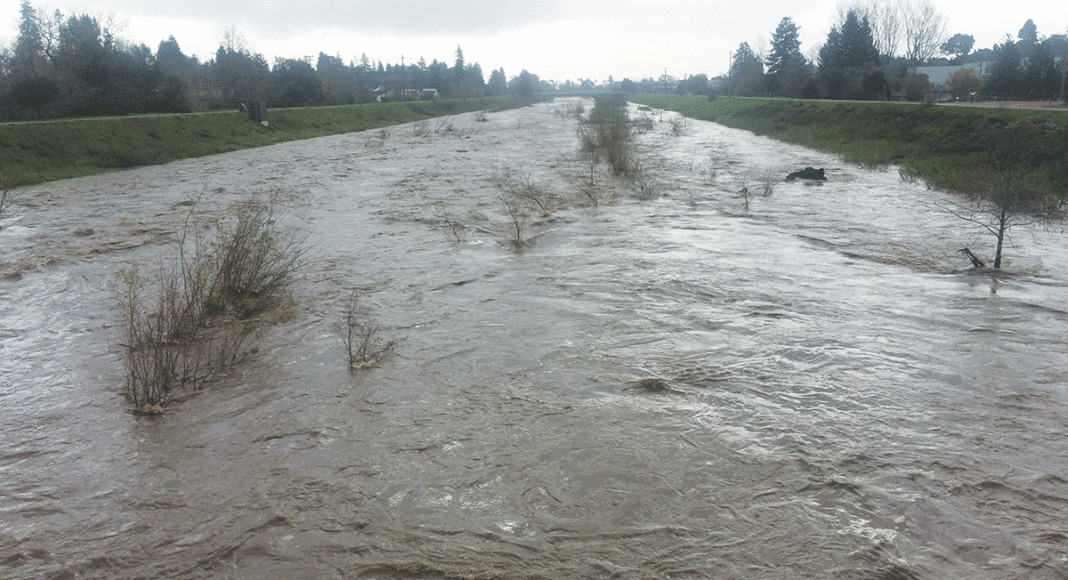The Santa Margarita Basin stretches from Highway 17 to Felton, under the homes and roads of Scotts Valley. The overdrafted aquifer has a few billion gallons of potential water storage capacity, which is more than some experts had imagined.
“It’s nobody’s basin. It just happens to be closer to us,” says Scotts Valley Water District (SVWD) General Manager Piret Harmon. “And it has been identified as a very suitable basin for water storage.”
Environmentalists and engineers have talked over the years about creating a regional water solution to provide long-term sustainability. Normally, that involves the city of Santa Cruz and the Soquel Creek Water District, as laid out in the 2015 Water Supply Advisory Committee (WSAC) recommendations. The basic idea is to rest drying mid-county groundwater wells with excess river water from the city of Santa Cruz that could eventually get pumped back during dry summers when the city is running low—a process sometimes called “conjunctive use.”
But another possibility suggested in those plans—although it garnered considerably less discussion for a long time—is the idea of similarly sharing flows with Scotts Valley. So in the past year, Harmon has been discussing regional solutions not just with Santa Cruz, but also with the neighboring San Lorenzo Valley Water District.
“This is something that’s being encouraged by the state, and we’re a little ahead of the curve. Water rights are a very arcane system,” says SVWD board vice president Chris Perri, who notes that pumping groundwater out of shared basins had gone wildly unregulated for years. “And water districts don’t tend to share well with each other. It goes way back in California. The old joke is that whiskey is for drinking and water is for fighting.”
Perri—who found local fame in the ’80s playing guitar for Eddie and the Tide—says the problem right now in Santa Cruz County isn’t a shortage of water at all. “It’s just in the wrong place at the wrong time,” he says.
Santa Cruz officials and San Lorenzo Valley Water District general manager Brian Lee are in the early stages of studying possible sites at which to inject winter water into the deceptively large basin under Scotts Valley. The SVWD Board also has the option of upgrading its recycled water plant and injecting that highly treated wastewater back into the basin to recharge the aquifer that way. It’s a project with a much heftier price tag, although Harmon will look into seeing if the district can secure grant funding. If successfully done together, these two options could provide a major water reserve.
All this would benefit SLVWD greatly, says Lee, whose board directed him to collaborate with other districts when it hired him two years ago. The water would support San Lorenzo Valley’s wells, and some of it would probably teem out into the mountain streams, too.
“Which is a good thing,” Harmon says, because higher stream flow would support fish habitat and supply a little extra drinking water as it rolls out to sea. “But when it comes to storage, we can’t have 50 percent of the storage constantly leaking.”
The three departments around the Santa Margarita Basin are forming a groundwater sustainability agency, which will begin meeting this year to develop a plan for managing the aquifer.
The Santa Cruz Water District, meanwhile, is near the beginning of a years-long process to study and implement the WSAC recommendations that initially grew out of activists’ fight against a proposed desalination plant. The pilot programs involve several moving parts, with staffers studying a number of questions.
In something of a chemistry experiment, the city’s water department is working with Soquel Creek leaders to create a pipe loop to test how water travels through the plumbing systems of the two agencies, as well as how the water supplies mix. Engineers want to make sure the pipes don’t corrode and the water doesn’t have any bad reactions. Next winter, experts aim to start drilling pilot wells to see how fresh water and underground basins react with one another.
If these options somehow fail to produce enough water at a low enough cost, the WSAC recommendations point the City Council to consider recycled water, with desal as a backup—two options experts are also looking at.
Staffers will finish their tests in the next three years, said Santa Cruz Water Director Rosemary Menard at a joint meeting with the Santa Cruz City Council and the water commission last week. After that, the council will vote on which water supply option to pursue by 2020, and workers will have until 2025 to finish the project.
Greg Pepping, who represented the Coastal Watershed Council on the WSAC, reminded the City Council that, whatever solution the city chooses, it must provide enough water flows to create substantial fish habitat.
David Baskin, another former WSAC member who now serves on the Water Commission, stressed that the council can’t kick this down the road. “The community has known that it had a serious water supply problem for some 50, 60 years. This is not the first time we’ve visited it. But this has to be the time that we actually get there,” Baskin said.
When it comes to recycled water, there are currently no specific guidelines for how to safely and legally distribute it in California. But the State Water Resources Control Board drafted a feasibility report in December, outlining how to develop healthy, foolproof standards for a method, not uncommon in other parts of the world, that’s sometimes known by the more crude nickname “toilet to tap.”
Although Santa Cruz appears to have quite a few water supply options in front of it, the city doesn’t have time to try them out one by one, before moving onto the next idea.
“We can’t do them sequentially,” City Councilmember Cynthia Mathews says. “We have to do them simultaneously in the piloting process.”














